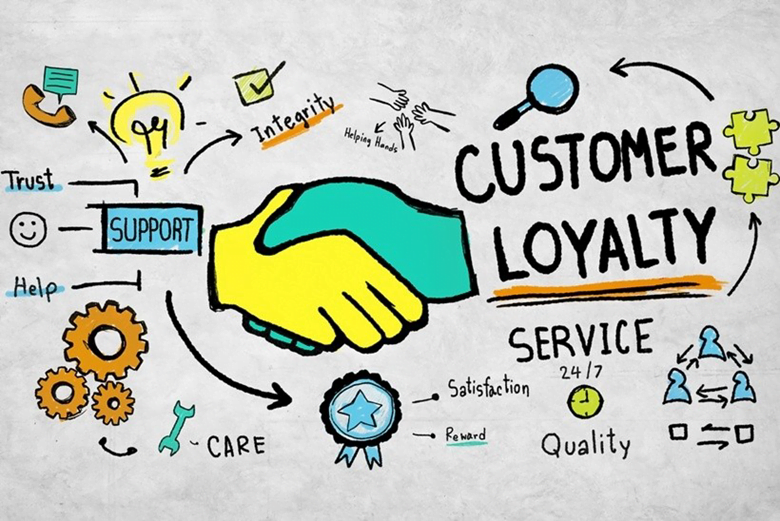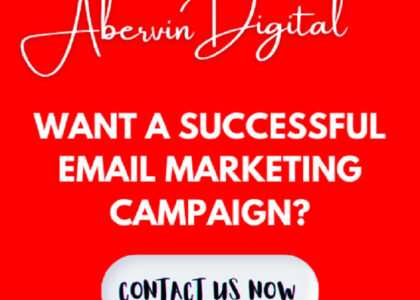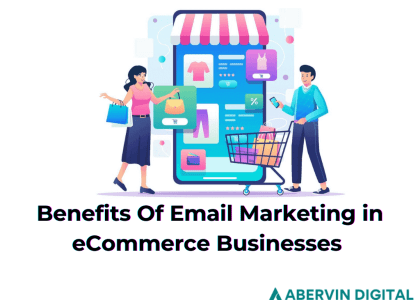How to Master B2C Marketing Strategies in 2025
In 2025, B2C marketing strategies are evolving fast. With consumers demanding more privacy and the decline of traditional tracking like cookies, business owners find themselves asking “How can my business win over customers in a world where personalization is key, but data privacy is king?”
This is the question on the minds of business owners everywhere. Consumers are more protective of their data, and to stand out, you need B2C marketing strategies that build trust and deliver personalized experiences without crossing privacy lines.
The internet-of-things has changed how people connect with brands, but one thing hasn’t changed: customers crave genuine, human connections. If you’re looking for the best way to future-proof your business, adopting smart, compliant B2C marketing strategies is your edge.
This guide will help you win in the fast-changing world of B2C marketing. Whether you’re launching your first store or running a well-known brand, you’ll find practical advice, actionable strategies, and tips to connect with customers, earn trust, and drive growth in 2025 and beyond.
What is B2C Marketing? (And Why Should You Care?)
B2C marketing is all about connecting directly with everyday people to promote your products or services. Unlike B2B marketing, which focuses on selling to other businesses, B2C is geared toward reaching regular shoppers – whether they’re scrolling on their phones, browsing in a store, or checking their email. It’s not just about making a sale; it’s about creating an experience that makes customers feel seen, understood, and appreciated.
Remember the last time you bought something online? Maybe it was some fresh kicks or that cool kitchen gadget you couldn’t stop thinking about. What got you to click “Buy”? Was it a catchy ad, a website that looked super clean, or maybe that discount email that hit your inbox right when you were looking for it?
That right there… that’s B2C marketing doing its thing. It’s all about setting up those moments and making them matter.
How You Benefit From Effective B2C Marketing Strategies
If you’re serious about building lasting customer relationships, B2C marketing strategies are your key. It’s about more than sales…it’s about showing customers why your brand matters.
Take Amazon as an example. They go beyond selling products; they craft experiences. From spot-on personalized recommendations to seamless checkout and follow-up emails, every step makes customers feel understood. That’s why they keep coming back.
This level of thoughtfulness is exactly what sets winning brands apart and why working with a skilled b2c marketing agency can help you craft this kind of journey for your customers.
B2B Marketing vs B2C Marketing
Whether it’s B2C (business-to-consumer) or B2B (business-to-business), the goal is the same: make money and grow. But how they go about it is pretty different. Let’s break it down.
Who They Target
When it comes to B2C, it’s all about people like you and me. Brands try to grab your attention by getting personal – playing on emotions, keeping up with trends, and solving your everyday problems. They want you to feel like, “Wow, they get me!” Maybe it’s a slick ad for the latest phone or a heartfelt story about how their product makes life easier. The point is to connect with you on a personal level and make you want to hit that “Buy Now” button ASAP.
Now flip the script to B2B. Here, it’s not about emotions – it’s about logic. They’re talking to decision-makers at companies who are looking for solutions, not feelings. These folks care about stuff like saving money, improving efficiency, and making smart, long-term investments. So instead of flashy ads, B2B marketers focus on showing how their product or service solves real business problems. It’s less about heartstrings and more about spreadsheets.
Sales Cycle (How Fast It Happens):
B2C is usually fast. You see a cool gadget on TikTok or a promo email with a sweet discount, and boom – you’re buying it before you even think twice. It’s all about instant gratification and making it super easy to say, “Yeah, I want that.”
B2B? Totally different vibe. The sales process is slower, more like a marathon than a sprint. There are meetings, proposals, and maybe a ton of back-and-forth before anyone makes a decision. Why? Because these are big-ticket purchases that can really impact a company’s bottom line, so they take their time to make sure it’s the right move.
Marketing Channels (Where They Hang Out):
For B2C, it’s all about where the people are. Social media, email campaigns, even teaming up with influencers – those are the go-to moves. It’s like they’re saying, “Hey, look at us! We’ve got something awesome, and you need it right now.”
B2B is a bit more buttoned-up. Think networking events, LinkedIn posts, and detailed guides or white papers that show off expertise. It’s not about quick clicks; it’s about building trust and saying, “We know what we’re doing, and we’ve got the data to prove it.”
Real estate marketing often falls into both B2C and B2B territory so if you work in that niche, our article on real estate email marketing in 2025 gives real-world examples of how to balance personalization and compliance.
How To Use Successful B2C Marketing Strategies in 2025
B2C marketing isn’t rocket science… it’s about connecting with people in a way that feels real and gets them excited about what you’re offering. When you tap into emotion, understand your customers’ needs, and keep the journey friction-free, your brand becomes the obvious choice.
Whether you’re a startup or scaling brand, nailing your B2C marketing game means blending heart with strategy and using the channels and tools that actually move the needle. Here’s what winning brands (and any smart B2C marketing agency) are doing right now.
1. Get to Know Your People
You can’t run effective B2C marketing without knowing exactly who you’re marketing to. A McKinsey study shows 71% of consumers now expect personalized interactions from brands. So, it’s not just about what you sell – it’s about understanding who you’re selling to. What makes them happy? What’s stressing them out? How do they like to shop?
Take time to dig into your customers’ habits, hopes, and hang-ups. Whether you’re selling skincare, courses, or coffee subscriptions, successful B2C marketing strategies in 2025 start with empathy. Cookie-cutter approaches just don’t cut it anymore – personalization is everything.
2. Make Content That Feels Real
In 2025, content that converts doesn’t feel like an ad — it feels like a message from a friend. The best B2C marketing strategies are story-driven, emotionally engaging, and actionable. Take Nike for example, it’s not just shoes they sell; it’s grit, determination, and “you can do it” vibes.
Whatever you’re putting out there – videos, blogs, emails, make sure it’s eye-catching, relatable, and easy to act on – so make sure you add clear calls to action that guide your audience on what to do next – whether it’s clicking a link, signing up, or making a purchase.
3. Use Data Without Losing Your Human Touch
Here’s the secret: data doesn’t replace creativity, it sharpens it.
With tools like Google Analytics, HubSpot, and even AI assistants, you can track what works, when people buy, and how to improve your B2C marketing campaigns. But the key is still writing and designing for humans.
Data can tell you when to send an email. It’s your job to make sure it feels like it came from someone who gets them.
If you’re working with a B2C marketing agency, make sure they’re not just crunching numbers but using those insights to create campaigns that actually connect.
4. Choosing the Right Channels
Not every platform deserves your energy. The most effective B2C marketing strategies prioritize where the audience already wants to engage.
Got a visually-driven product? Instagram or TikTok are gold. Selling essentials or courses? Email marketing is still unmatched.
Focus your content where your people already spend their time and stop trying to be everywhere. A great B2C marketing agency will help you build a channel strategy around behavior, not just trends.
5. Make Every Customer Experience Memorable
Experience is the new currency.
PwC reports that 73% of consumers say customer experience plays a major role in purchase decisions. That includes everything from your website’s ease-of-use to how quickly you reply to support emails.
Your B2C marketing efforts shouldn’t stop at the sale, they should create repeat moments of delight. A clear path to checkout, fast-loading pages, and human-first service all contribute to a brand experience people rave about (and return to).
Understanding Your B2C Customer
So here’s the thing… you can’t build high-performing B2C marketing strategies without understanding what makes your buyers tick.
That means digging into psychology and understanding what catches their eye, what makes them hesitate, and what emotions drive them to say, “I need this now.”
Whether you’re building out personas or looking at buying behavior data, your end goal is to market to real humans… not some generic segments.
1. Buyer Psychology: What Really Drives People to Buy
B2C marketing thrives on emotional connections, while B2B transactions often focus on logic, efficiency, and ROI. The truth is when it comes to buying things, most of us don’t make decisions with just our heads. We buy with our hearts. Unlike B2B, where logic and ROI rule, B2C marketing strategies succeed when you tap into how people want to feel. Whether it’s the joy of grabbing a deal, the pride of doing something great for your family, or the convenience of saving time, emotions steer the ship.
Think about it like this:
- Parental Pride: A parent might spend extra on organic baby food because it makes them feel like they’re giving their kid the best start in life.
- Fitting In: A college student buying the trendiest backpack? It’s not just about carrying book – it’s about feeling like they belong.
- Making Life Easier: Busy professionals will jump at products that promise to save time or cut down on hassle.
When you can tap into these emotional drivers, your marketing becomes more than just selling a product. It’s about creating a connection that sticks.
2. Buyer Personas: The Foundation of Effective B2C Marketing Strategies
If you’re serious about building effective B2C marketing strategies, it starts with knowing exactly who you’re talking to. Enter: buyer personas – detailed profiles of your ideal customers based on real data, not guesses.
Think of them as the compass guiding every decision in your B2C marketing playbook. Without personas, you’re just tossing messages into the void, hoping something sticks.
Here’s how smart B2C marketing agencies build buyer personas that actually drive results:
- Gather Real Insights: Surveys, support chat logs, analytics tools, and social media polls reveal what your customers care about and how they talk.
- Spot Patterns: Are they budget-conscious students? Eco-focused millennials? Suburban parents juggling work and life?
- Create Profiles: Give each one a name and a relatable story. For example:
- “Busy Brenda”: She’s a a time-starved mom who shops on mobile and loves convenience.
- “Techie Tim”: A gadget-loving college student who’s always hunting for the best deal online and reads reviews before he buys.
- “Busy Brenda”: She’s a a time-starved mom who shops on mobile and loves convenience.
Now your B2C marketing strategies can speak to each type of customer. Brenda wants quick solutions that simplify life. Tim wants specs, discounts, and validation. By using buyer personas to segment and personalize, you’ll stop blending in and start breaking through..
3. Data-Driven B2C Marketing: Stop Guessing, Start Converting
One of the most overlooked yet powerful B2C marketing strategies is using data to make your campaigns smarter.
Modern B2C marketing agencies rely on real-time insights to refine messaging, segment audiences, and optimize spend. This is about knowing what actually drives conversions.
Here’s how to make your data work harder:
- Track Behavior: Use Google Analytics or your CRM to see where people click, how long they stay, and what paths they take before converting.
- Analyze Purchase History: Learn what sells well seasonally, what gets bundled together, and which products get abandoned in carts.
- Listen to Their Voice: Review surveys, testimonials, and social comments to uncover what customers actually think…not just what they buy.
The best B2C marketing strategies take all of this and turn it into smarter actions: dynamic content, personalized recommendations, and timely campaigns.
The Best B2C Marketing Channels for 2025
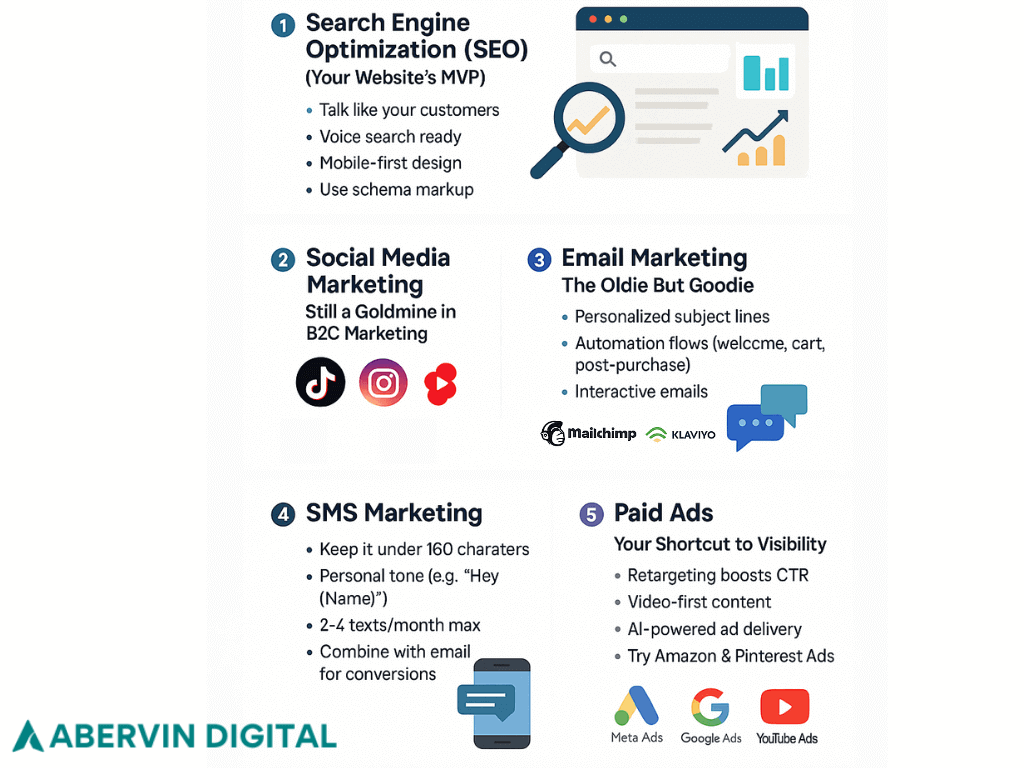
If you’re serious about standing out in 2025, having the right B2C marketing strategies and understanding which channels work and how to use them is your unfair advantage.
Here’s what’s working now (and how to actually use it).
1. Search Engine Optimization (Your Website’s MVP)
Think of SEO as the backbone of smart B2C marketing strategies. It’s how ideal customers find you organically when they’re searching for products, solutions, or answers. Over 53% of all web traffic comes from organic search. That’s too big to ignore.
How to Win with SEO in 2025:
- Talk Like Your Customers: Ever Googled, “What are the best running shoes?” Yeah, your customers do the same. Think about the questions your audience asks, like “How do I pick the right running shoes?” Write blogs or guides that answer real questions your audience types into Google.
- Get Voice Search-Ready: By 2025, more than half of households will have smart speakers. Use natural phrases like “best restaurants near me” or “what’s the best protein powder for women” in your content to help you rank.
- Go Mobile or Go Home: Over half of all web traffic happens on phones. Make sure your site looks great and loads fast on mobile – nobody’s waiting more than three seconds.
SEO Pro Tip: Use schema markup (a fancy term for structured data) to make sure search engines understand your content. It’s like giving Google a cheat sheet to understand your site which helps you show up in snippets and other prime spots on Google.
2. Social Media Marketing: Still a Goldmine in B2C Marketing
If you’re in B2C marketing, social media is your digital word-of-mouth. 80%+ of consumers say social content influences their buying decisions. Platforms like Instagram, TikTok, and YouTube Shorts are more than “nice to have” they’re your front lines.
How to Own Social in 2025
- Stay Consistent: Posting regularly trains the algorithm and keeps you on people’s radar. And hey, tools like Buffer can do the heavy lifting for you.
- Get Customers Involved: People trust what other people say more than ads. Encourage your customers to post about your products and tag you – it’s authentic and free!
- Keep It Real: Use Instagram Stories, TikTok polls, or even a quick Facebook Live Q&A. People love engaging content that feels personal.
Social Media Pro Tip: Avoid overly polished content; 62% of users prefer authentic, relatable posts over “salesy” ads. Showcasing behind-the-scenes moments or using interactive features like think polls, live videos, or Instagram Stories can make your audience feel like they are part of the conversation. Throw in customer testimonials to give your brand a human feel.
3. Email Marketing: The Oldie But Goodie
Email’s like that reliable friend you can always count on. Sure, it’s old-school, but it remains one of the highest-ROI tools in b2c marketing strategies, earning up to $36 for every $1 spent
How to Win at Email Marketing in 2025
- Personalized Messaging: Emails with personalized subject lines are 26% more likely to be opened. Use tools like Mailchimp or Klaviyo to segment your audience based on behavior, demographics, or purchase history.
- Automation and Triggers: Set up automated flows such as welcome emails, abandoned cart reminders, or post-purchase thank-you notes to maintain engagement. We explore this in-depth in another blog – 4 Must-Have Ecommerce Email Automations to 10X Your Online Store’s Revenue
- Interactive Emails: Add some spice with interactive stuff like embedded videos, surveys, or clickable carousels to make your emails more engaging.
Email Marketing Pro Tip
Focus on growing a strong email list with lead magnets like free guides or discounts. Don’t buy lists – they’re usually a waste of time and can hurt your sender reputation if you do not know what you’re doing.
4. SMS Marketing
If you’re not using SMS yet, you’re missing out. With 98% open rates, it’s one of the fastest ways to drive urgency and response especially when paired with email in a full B2C marketing strategy.
SMS Tactics for 2025:
- Keep It Short: Nobody’s reading a novel via text. Stick to under 160 characters and get to the point with clear CTAs like “Check out our new arrivals: [link].
- Make It Personal: A quick “Hey [Name], your favorite hoodie is back!” feels way better than generic ones.
- Don’t Be Annoying: Sending 2-4 texts a month hits the sweet spot.
SMS Pro Tip
Combine SMS with email or social media. For example, follow up an email promotion with a quick text reminder. See how pairing SMS and email marketing boosts conversions for ecommerce.
5. Paid Ads: Your Shortcut to Visibility
Organic can take time. Paid ads especially when used strategically can put your B2C marketing strategies on fast-forward. In 2025, digital ad spend is expected to top $650B globally. Why? Because it works when done right.
How to Advertise Smarter in 2025:
- Retargeting Campaigns: Ever looked at a product online, then saw an ad for it later? That’s retargeting. It works because people need reminders!. Retargeting ads have a click-through rate (CTR) ten times higher than display ads. Use tools like Google Ads or Facebook Pixel to re-engage users who’ve interacted with your site. Learn more about retargeting campaigns in 11 expert-approved ways to grow your ecommerce brand.
- Run Video Ads: With video making up 82% of internet traffic, platforms like YouTube and TikTok are where you want to be.
- Use AI for Ad Optimization: Platforms like Meta Ads Manager use AI to identify your best-performing ads and optimize delivery, ensuring better results for your spend.
Paid Advertising Pro Tip
Don’t put all your ad dollars on just Google or Facebook. Check out up-and-comers like Amazon Ads or Pinterest – they’re growing fast in B2C. Done right, these B2C marketing strategies can help you build real connections and grow your biz without feeling salesy or fake.
7 B2C Marketing Strategies to Grow Your Business in 2025
In 2025, the key to great marketing is meeting your audience where they’re hanging out – whether that’s on TikTok, their inbox, or Google. It’s all about creating real connections and turning those into action, so keeping your content authentic, making it personal, and always thinking about what your customer needs most is how you win in 2025.
B2C (Business-to-Consumer) marketing is particularly dynamic, focusing on creating meaningful interactions and driving conversions.
If you’re a brand, entrepreneur, or even a B2C marketing agency looking to grow, here are 7 tested strategies to elevate your game this year.
1. Welcome Series
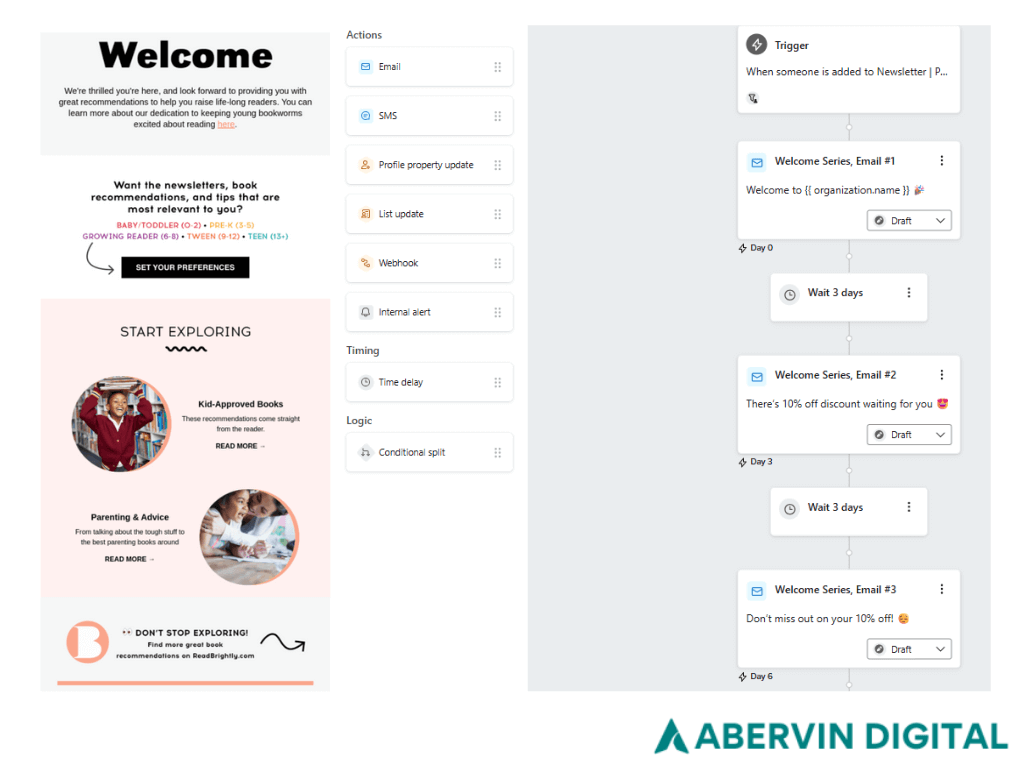
One of the most overlooked B2C marketing strategies is a well-executed welcome email series. When someone signs up for your list, they’re curious and engaged…don’t waste that moment..
Why It Works: You know how a warm, genuine “hello” can instantly brighten someone’s day? That’s the vibe your welcome emails need. People actually look forward to these! They’re not just skimming – they’re engaged. In fact, welcome emails get way better open rates (50-60%) than your average email (around 20%). That’s your golden opportunity to:
- Show off your brand.
- Build trust.
- Get them to take the next step – whether that’s buying, signing up, or just exploring.
It’s all about timing and curiosity. Someone who just subscribed is into you. Your email shows up right when they’re most excited. It’s like catching someone right after they’ve decided to walk into your store – they’re ready to see what you’ve got.
How to Create A High Converting Welcome Series
Think of your welcome series as a conversation, not a sales pitch. You’re getting to know each other, so don’t hit them with too much too soon. Here’s a simple game plan:
1. Start with a Warm Intro
Your first email is your “excited nice to meet you” opportunity and it’s up to you to make it count:
- Share your story: Who are you, and why do you do what you do? Keep it short and real.
- Show what matters to you: Are you eco-friendly? A family business? Do you give back to the community? Let them know what makes you stand out.
- Highlight your favorites: Got a best-selling product or service? Show it off with some great images and links.
2. Give Them a Reason to Stick Around
People love perks. Sweeten the deal by offering something right away, like:
- A discount code (10% off is a crowd-pleaser).
- A freebie – like a guide, checklist, or webinar.
- A heads-up about exclusive perks or loyalty programs.
Look at IKEA – they roll out the red carpet with loyalty points and decorating tips, making new subscribers feel like part of the family.
3. Spread It Out
Instead of a one-and-done email, go for a mini-series – 3 to 5 emails spaced over a week. It keeps the convo going without overwhelming anyone.
Here’s a quick roadmap:
- Day 1: Say thanks, introduce yourself, and share your mission.
- Day 3: Show your best stuff and toss in a discount code.
- Day 5: Share customer love – reviews or success stories that build trust.
- Day 7: Add more value (free shipping, exclusive content) and encourage a specific action, like joining your loyalty program.
4. Make It Personal
Use what you know about your subscribers to tailor the experience. For example, if someone signs up from a certain city, recommend local services or highlight region-specific options.
Brands That Do This Right
- IKEA: They focus on perks and decorating tips while keeping things super friendly.
- Headspace: This meditation app guides new users step-by-step, sharing tips and nudging them toward premium features without feeling pushy.
- Nike: They go big on inspiration – highlighting products, values, and training tips that make you want to hit the ground running.
When you put thought and heart into your welcome series, it’s more than just emails. It’s the start of a relationship. Show them who you are, make them feel valued, and watch how far that first impression can take you.
2. Memberships and Loyalty Programs
Loyalty can be orchestrated with the right strategy. One of the most profitable B2C marketing strategies today is building a membership or rewards system that makes people want to stick with you.
Whether it’s earning points for every dollar spent, unlocking perks after a certain number of visits, or joining a VIP club, these programs reward customers for sticking with your brand. It’s a win-win: they get something extra, and you get their repeat business.
Why It Works: There’s some real science behind why loyalty programs work so well. First, they tap into basic human feelings – like wanting to feel valued and rewarded. People like getting perks that make them feel special, and businesses can use this to build stronger relationships.
- 77% of customers say they’re more likely to stay loyal to a brand with a good rewards program (Bond Brand Loyalty).
- 67% more spending happens with repeat customers who are part of a loyalty program (Invesp).
What’s more, companies with solid loyalty programs often see a 30% to 40% boost in customer lifetime value (McKinsey). When customers feel rewarded, they’re not just spending more – they’re staying around longer.
How to Build a Membership System That Works
- Add Tiers People Want to Reach
Add some excitement with tiers or levels. The more customers spend, the better the perks they unlock. Think about how Starbucks lets you move from “Green” to “Gold” status, with free drinks and birthday treats at the top level. It’s like a little game, and people love “winning.” - Make Rewards Feel Personal
Nobody wants a one-size-fits-all reward. Look at what your customers actually care about – like what they buy or how they interact with your brand – and give them perks they’ll use. For example, Amazon Prime nails this with free shipping and exclusive content that make life easier for members. - Offer Perks That Feel Exclusive
Everyone loves feeling like they’re part of a special club. Offer members-only perks, like early access to new products, VIP service, or exclusive discounts. Sephora’s Beauty Insider Program crushes it by giving members sneak peeks and invites to special events.
Real-Life Examples That Get It Right
- Starbucks Rewards: It’s simple – spend money, earn stars, and trade them for free drinks or snacks. The app makes it easy to track and even suggests drinks based on what you’ve ordered before.
- Nike Membership: Nike keeps it exclusive with early access to limited-edition gear, invites to workout classes, and events for members only.
- Delta SkyMiles: Perfect for frequent flyers, Delta’s program offers free flights, seat upgrades, and other perks the more you fly.
Loyalty programs aren’t just about free stuff – they’re about making people feel good. When customers feel like they’ve earned rewards, they see your brand as thoughtful and generous.
And here’s the kicker: once they’ve started racking up rewards, they’re more likely to stick around because they don’t want to lose what they’ve already earned (it’s called the “sunk-cost bias”).
Whether you’re a growing brand or partnering with a B2C marketing agency, building a loyalty program that feels thoughtful and well-timed can turn one-time buyers into long-time fans.
3. Personalization Through Quizzes
Here’s the thing about smart b2c marketing strategies in 2025: they don’t guess what your customer wants… they ask. And the best tool for that is a quiz. Think of it as your digital barista. It remembers your customer, asks the right questions, and recommends exactly what they need… automatically, 24/7.
And quizzes are essentially conversion machines. They create engaging moments and gather zero-party data: info that customers share willingly. For any B2C marketing agency or small brand, that data is a goldmine for personalization and future campaigns.
Why It Works: Let’s talk numbers. According to McKinsey, personalized marketing delivers 5–8 times more ROI than generic approaches. It’s like the difference between a generic coffee pod and a freshly brewed latte – one just hits better.
The smartest B2C marketing strategies lean into human curiosity. Whether it’s discovering “the perfect skincare routine” or “what kind of traveler you are,” people enjoy the process. When you tie that curiosity to your brand, everyone wins: your customers have fun, and you get invaluable insights.
How to Use Quizzes in Your B2C Marketing Strategy
- Keep It Quick and Easy
Nobody wants to spend ages answering questions – save the essay-length stuff for college apps. Stick to 5–10 questions, and make sure they’re simple and engaging. Each question should take no more than 10 seconds to answer.
Pro Tip: Keep the tone conversational. Instead of asking, “What’s your skin type?” try, “How does your skin usually feel during the day?” - Make It About Your Brand
Your quiz should feel like an extension of your business, not a random add-on. Selling skincare? Ask about skin concerns and routines. In the travel biz? Focus on dream destinations and travel styles.
The goal is for the customer to have a seamless journey from quiz to product recommendation. Each question should lead to something actionable.
Example: A fitness brand could offer a “Find Your Ideal Workout” quiz, asking about fitness goals, current habits, and preferences. The results could recommend workout plans and products like resistance bands or protein shakes. - Put Quiz Results to Work
Once someone completes a quiz, use that data to personalize their experience even further:
- Emails: Segment your email list based on quiz results and send tailored recommendations. For instance, someone with “oily skin” gets product suggestions specifically for that concern.
- Ads: Use quiz insights to run super-targeted retargeting ads. If a customer showed interest in “lightweight moisturizers,” highlight those products.
- Website Experience: Personalize what they see the next time they visit. Show them products or content that align with their quiz answers.
A Real-Life Example: Sephora’s Skincare Finder
Sephora’s “Skincare Finder” quiz is a perfect example of how to do it right. Customers answer a few questions about their skin type, concerns, and habits. In return, they get product recommendations that fit their needs.
What makes it so effective? It’s short, straightforward, and perfectly aligned with Sephora’s product range. Plus, the recommendations make it easy for customers to go from quiz results to checkout.
Adding a personalized quiz to your marketing strategy helps build genuine connections with your audience and shows your customers that you get them while giving you the insights to create campaigns that truly resonate.
So, whether you’re selling skincare, coffee, or fitness plans, consider making quizzes part of your game plan. When done right, they’re power plays in your broader b2c marketing strategies.
4. Contests and Giveaways
When it comes to effective B2C marketing strategies, few tactics drive faster results than a well-run contest or giveaway.
These campaigns are crowd-pleasers and not just because people love winning. Contests help B2C brands grow their audience, boost engagement, and generate leads without feeling pushy or salesy.
So, if you’re looking for a B2C marketing move that’s high-impact, low-cost, and buzz-worthy, this one’s a no-brainer.
Why They Work so well
In short, it’s one of the most underrated B2C marketing strategies to generate visibility and connection in one swoop. Here’s why contests and giveaways are such a hit:
- They Grow Your Following Fast: Accounts running giveaways on Instagram, for example, grow followers way faster. (Tailwind says it’s 70% faster, to be exact!). The promise of winning entices users to follow, like, and share.
- Engagement Goes Through the Roof: Who can resist tagging a friend or leaving a comment for the chance to win? People are naturally drawn to free or exclusive rewards. When asked to like, comment, or tag friends, participants actively engage with your brand, increasing visibility and interaction.
- They’re a Lead Magnet: Contests often require participants to provide an email address or complete a form, making them excellent for building your marketing list.
- Good Vibes for Your Brand: By offering prizes that that fit your vibe and your audience’s interests, you create a positive association that fosters loyalty makes your brand more relatable and likable.
How to Run a Contest or Giveaway That Actually Works
Success doesn’t just happen – it’s planned. Here’s a step-by-step guide to running a winning contest or giveaway:
- Set Clear Goals: Before launching, identify what you want to achieve. Trying to build up your email list? Drive traffic to your website? Increase social media engagement? Having a clear goal keeps things focused.
- Know Your People – If you want folks to jump into your contest, you gotta make it about them. What gets them hyped? What headaches can you take off their plate? Pick a theme and prizes that feel like they were handpicked just for them – that’s how you get people to show up.
- Choose Relevant Prizes: The prize is the heart of your campaign so it has to be something they actually care about.. Select something valuable and relevant to your audience. For example, a fitness brand might offer workout gear or free training sessions, while a tech company could give away gadgets or software subscriptions.
- Create Simple Rules: Complicated entry processes deter participation. Make it easy: ask users to follow your account, like a post, or tag a friend. For contests, ensure criteria are clear and achievable.
- Encourage Sharing: Want more reach? Encourage participants to share your contest. Introduce branded hashtags or offer additional entries for referrals. User-generated content, like photos or testimonials, can also boost visibility.
- Use Social Media Tools: Platforms like Instagram and TikTok offer features like polls, stories, and reels that can make your contest more engaging. Use countdown timers or live announcements to build excitement.
- Measure Results: After it’s all said and done, look at what worked. Did you get the followers, leads, or traffic you were hoping for? Use these insights to refine future campaigns.
B2C Marketing Example That Nailed It: REI’s #OptOutside Campaign
Here’s one for the books: Outdoor brand REI ditched Black Friday sales and encouraged people to spend the day outside instead. They launched the hashtag #OptOutside, asking folks to share their outdoor adventures. With over 1.4 million mentions and a 7% sales boost, this was more than a feel-good moment… it was one of the smartest B2C marketing strategies in recent memory. And it worked because it was simple, shareable, and deeply aligned with their values.
5. Abandoned Cart Emails
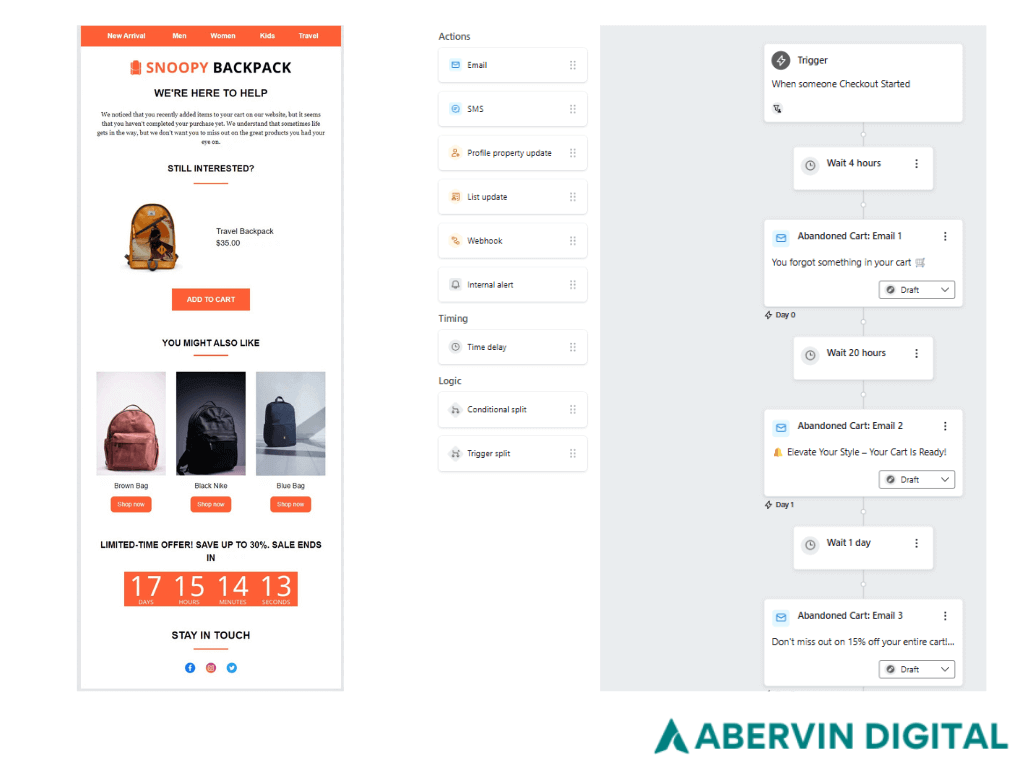
Every shopper’s been there. You’re browsing, you fall in love with a product, add it to your cart… then life gets in the way. A phone call, a kid crying, second thoughts…and just like that, the cart’s abandoned.
It’s not just you… nearly 70% of shoppers ditch their carts (Baymard Institute). But this is where smart B2C marketing strategies come into play. One of the most effective tactics? Abandoned cart emails.
An Abandoned Cart Email is exactly what it sounds like – an email that gives shoppers a little nudge, like, “Hey, you almost bought this!” It’s kind of like when you order food at a drive-thru, pull away, and realize you forgot the fries. That email is the friendly voice saying, “Want to grab those before you go?”
Most shoppers don’t abandon their carts because they’ve lost interest. They’re often dealing with:
- Unexpected costs – Extra fees like shipping or taxes can be dealbreakers.
- Distractions – They meant to check out but got sidetracked.
- Indecision – They’re unsure if it’s the right product or the right time.
Your abandoned cart email should remind them why they wanted the product in the first place and address their hesitations. And the best part? you can automate it – once you set it up, it works on autopilot.
How to Write an Abandoned Cart Email That Converts
Here’s how to turn those almost-sales into actual revenue:
1. Don’t Just Send One Email… Send a Sequence
One email is good. Three is better.
A single reminder email is okay. But part of the best B2C marketing strategies involves multi-step follow-ups. Campaigns that send 3-cart recovery emails can increase revenue by over 50% (Omnisend).
The ideal sequence:
- Email 1: The Reminder (1-2 hours after abandonment) – A casual nudge: “Hey, you left something behind!”
- Email 2: The Incentive (24 hours later) – A small discount or free shipping to remove hesitation.
- Email 3: The Urgency (48 hours later) – A reminder that the cart will expire or that stock is running low.
This combo works because it tackles hesitation, timing, and psychology… the trifecta of solid B2C marketing.
2. Offer an Irresistible Incentive
Price is one of the top reasons shoppers abandon their carts and incentives are a secret weapon in many B2C marketing strategies because they go a long way in bringing shoppers back.
Try these proven tactics to sweeten the deal and close sales:
- Discounts – A 10% off code can be enough to seal the deal.
- Free shipping – A major purchase motivator – unexpected shipping costs are responsible for 48% of cart abandonments
- Bonus gift – Something small but valuable (e.g., a free trial, a downloadable guide, or a sample).
3. Remind Them Why They Wanted the Product
People add items to their cart for a reason. Your email should reignite that excitement.
- Highlight the benefits – What problem does the product solve?
- Use social proof – Share customer reviews or testimonials.
- Include personalized recommendations – If they liked one product, they might like another.
Amazon does this exceptionally well. Their abandoned cart emails not only remind shoppers of what they left behind but also suggest related items. It’s like a buddy nudging you and saying, “Hey, this might be right up your alley.”
4. Make It Easy to Check Out
A smart B2C marketing strategy includes reducing friction at every step. Your abandoned cart email should have a clear, single call-to-action (CTA). No distractions, no extra clicks. Just a big, bold button that says:
[👉 “Return to Your Cart”]
Bonus points for pre-filling their cart so they don’t have to start over.
Real-World Example: Amazon’s Abandoned Cart Strategy
Amazon is the king of getting people to complete their purchases. Their abandoned cart emails follow a simple but powerful formula:
- Urgency – “Your cart is about to expire!”
- Personalization – “Customers who bought this also bought…”
- Seamless checkout – One-click purchase option.
It works because it removes friction. It makes going back to checkout feel effortless.
Abandoned cart emails are one of the easiest ways to boost your revenue without spending more on ads. With the right mix of reminders, incentives, and urgency, you can recover a huge chunk of lost sales.
So, if you haven’t set up your abandoned cart emails yet, now’s the time. Because every cart left behind is money left on the table.
6. Win-Back Campaigns
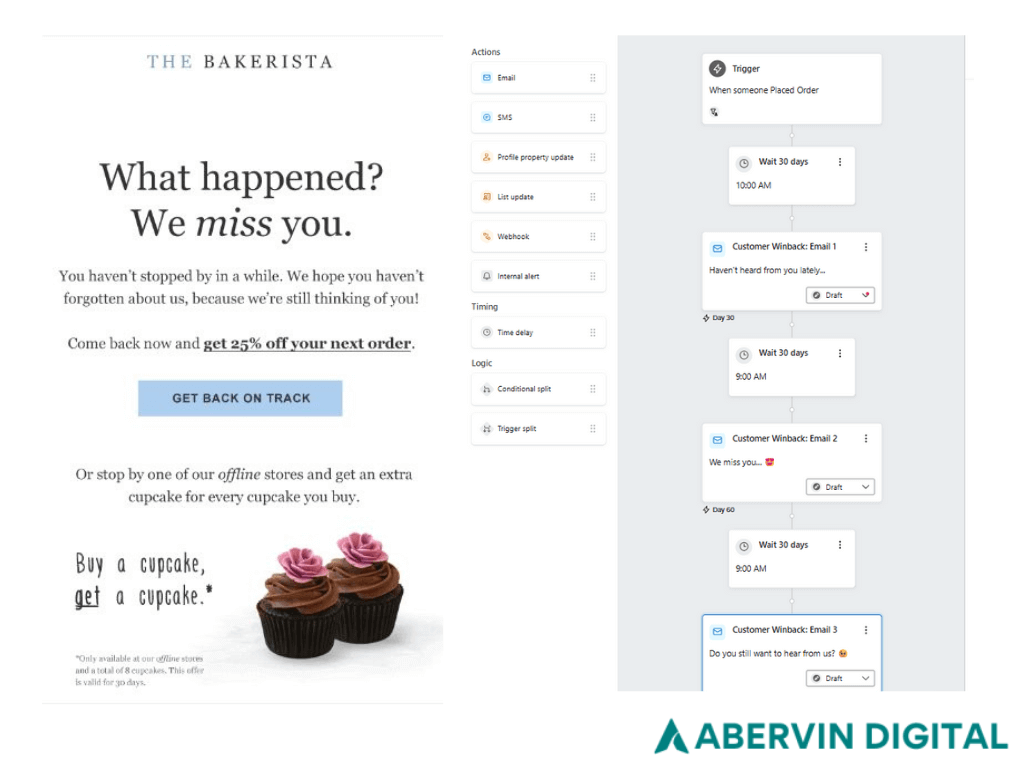
Ever had a customer just… disappear? Maybe they bought something once and never came back. Or they used to be super engaged but suddenly ghosted you. That’s where a win-back campaign comes in.
It’s basically a strategic way to reconnect with past customers, remind them why they loved you in the first place, and give them a little nudge to come back. The goal? Reignite interest, rebuild trust, and get them buying again.
Re-engaging past customers is significantly more cost-effective than acquiring new ones because selling to someone who already knows you is way easier than convincing a total stranger. According to Marketing Metrics, the probability of selling to an existing customer is between 60-70%, while the likelihood of converting a new prospect is only 5-20%. Additionally, studies show that winning back a lost customer can cost 5-10 times less than attracting a new one.
Think about it – these people already trusted you enough to make a purchase before. Maybe they just got busy,
How to Run a Win-Back Campaign That Works
A solid win-back email isn’t just a “Hey, come back!” message. It’s about making customers feel appreciated, not just another sale. Here’s how to do it right:
1. Segment Your Audience
Not every lapsed customer is the same, so don’t treat them like they are. Instead, group them into categories based on behavior, like:
- Time Since Last Purchase: Customers who haven’t purchased in 3 months, 6 months, or a year.
- Browsing Habits: Those who visited product pages but didn’t complete a purchase.
- Past Spending: Big spenders might need a VIP offer, while one-time buyers may need a different approach.
- Engagement Level: Customers who used to open emails but stopped engaging might need a different approach than those who never open them.
With the right customer relationship management (CRM) software or marketing automation tools, you can personalize messages based on what they actually care about.
2. Make Your Message Count
Your message should feel natural, personal, and engaging -not cold or generic. Here are some key elements to include:
- A Friendly Greeting –Address the customer by name and reference something personal, like their last purchase.
- A Reminder of Why They Loved You – Reinforce why they chose your brand in the first place. and highlight what makes your brand great.
- A Human Touch – Keep it casual. A simple “Hey, it’s been a minute! Everything good with you?” feels real. You can also use storytelling to reconnect with the customer on a personal level.
- A Clear Call to Action – Let them know what to do next. Whether it’s a discount, an exclusive offer, or a new feature, make it easy for them to take the next step.
3. Give Them a Reason to Come Back
Sometimes, people just need a little extra reminder. Try offering:
- Special Discounts – “Snag 20% off- just because we miss you.”
- Loyalty Perks – Rewarding them with extra points for returning. “Come back now and earn double rewards.”
- Early Access – Early access to new collections or limited-time deals. “Get first dibs on our latest collection!”
- Free Shipping – “No shipping fees this week- just for you!”
4. Show What’s New
A customer may have disengaged because they didn’t find what they needed before. Use your win-back campaign to show them what’s changed.
- New Products or Services that align with their past interests. – “Just launched- you’ll love it.”
- New & Improved Features – “We’ve leveled up! Check out what’s new.”
- Customer Testimonials – “Here’s what others are saying about us now.”
5. Use Multiple Channels
Win-back campaigns work best when they utilize multiple touchpoints. Consider integrating:
- Email Marketing: A well-designed email with a personalized subject line and compelling CTA.
- SMS Marketing: A short, exclusive offer sent via text message.
- Retargeting Ads: Dynamic ads reminding them of abandoned carts or new deals.
- Social Media Engagement: Using social media platforms to re-engage through organic posts or targeted ads.
A Real-Life Example: ASOS’ Successful Win-Back Campaign
Fashion retailer ASOS is known for its effective win-back emails. When a customer hasn’t made a purchase in a while, ASOS sends an email with a subject line like “We Miss You! Here’s 20% Off”. The email includes a limited-time offer, an eye-catching image, and a clear CTA leading to their best-selling products. This approach taps into urgency, personalization, and customer psychology, making it highly effective in reactivating dormant buyers.
Why it works:
- It’s personalized (they know you’ve been inactive).
- It creates urgency (limited-time offer).
- It makes taking action super easy (clear call to action).
Measuring Win-Back Campaign Success
To evaluate the effectiveness of your win-back campaign, track these key performance metrics:
- Reactivation Rate: The percentage of inactive customers who make a purchase after receiving the campaign.
- Click-Through Rate (CTR): The number of customers who engage with your win-back email or ad.
- Conversion Rate: The percentage of returning customers who complete a transaction.
- Customer Lifetime Value (CLV): The long-term revenue generated by reactivated customers.
Win-back campaigns are a powerful tool for businesses looking to successfully re-engage past buyers. Given that it costs far less to win back a customer than to acquire a new one, investing in a well-structured win-back campaign can be one of the most cost-effective marketing strategies in your arsenal.
7. Retargeting and Lookalike Audiences
Have you ever browsed for a pair of sneakers, left the website, and then started seeing ads for those exact shoes everywhere? That’s retargeting in action. It’s a digital advertising strategy designed to reconnect with people who have already interacted with your website, app, or content but didn’t convert.
Then there’s lookalike audiences, a feature offered by platforms like Facebook, Google, and TikTok, which takes your best customers and finds new prospects who share similar demographics, interests, or behaviors. Essentially, it’s like cloning your best buyers – without the ethical concerns of actual cloning.
Why It Works: The Numbers Speak for Themselves
Retargeting and lookalike audiences aren’t just buzzwords; they deliver tangible results. Let’s break it down:
- Higher Engagement: Retargeted ads have a 10x higher click-through rate (CTR) than standard display ads, according to Criteo. Since these users have already shown intent, they’re far more likely to engage.
- Increased Conversions: A study by WordStream found that website visitors who are retargeted are 70% more likely to convert compared to those who aren’t.
- Lower Customer Acquisition Costs: Lookalike audiences help businesses scale efficiently by targeting high-intent users, which leads to better ROI on ad spend.
- Better Brand Recall: Google reports that remarketing ads can increase brand awareness by 104%, making it easier for consumers to recall and engage with your brand later.
How to Implement: A Step-by-Step Guide
1. Set Up Retargeting Campaigns with Facebook and Google Ads
The first step is capturing audience data using tracking pixels (Facebook Pixel, Google Ads Remarketing Tag, etc.). These tiny snippets of code track visitors and allow you to serve them relevant ads after they leave your site.
- Facebook & Instagram Ads: Use the Facebook Pixel to segment users based on their actions- viewing a product, adding to cart, or visiting specific pages.
- Google Display Network (GDN): With Google’s remarketing feature, your ads can follow users across over 2 million websites, YouTube, and even Gmail.
- TikTok and LinkedIn: If your audience is active on these platforms, their retargeting tools can be equally effective.
2. Define Lookalike Parameters to Reach High-Intent Users
Once you have a robust list of existing customers or high-value website visitors, you can create lookalike audiences to find new people who resemble them.
- Start with Quality Data: Upload your best-performing customer lists (e.g., high-LTV customers, repeat buyers) to Facebook, Google, or LinkedIn.
- Adjust the Similarity Scale: Facebook allows you to choose how closely the new audience resembles your original one (1% for close matches, up to 10% for broader reach).
- Test Different Segments: Run multiple variations like a lookalike based on past purchasers vs. a lookalike based on email subscribers-to see which performs best.
3. Optimize with Performance Tracking
Data-driven marketing means nothing without tracking. Monitor key performance indicators (KPIs) such as:
- Click-Through Rate (CTR) – Are users engaging with your ads?
- Conversion Rate (CVR) – How many retargeted visitors actually convert?
- Cost Per Acquisition (CPA) – Are you acquiring customers efficiently?
- Return on Ad Spend (ROAS) – Are you getting back more than you’re putting in?
Use A/B testing to experiment with different ad creatives, messaging, and offers to fine-tune your campaigns.
Real-World Example: Casper’s Retargeting Playbook
Casper, the popular mattress company, executes retargeting brilliantly. If you visit their site and browse a mattress but don’t buy, they’ll follow up with dynamic retargeting ads showing the exact product you viewed – sometimes with an added incentive like a discount or free pillows. This approach keeps the product top-of-mind and increases the likelihood of conversion.
If you’re not using retargeting and lookalike audiences, you’re leaving money on the table. These strategies allow you to:
- Re-engage potential customers who didn’t convert the first time.
- Find new customers who match your top buyers.
- Improve your ad efficiency and lower your acquisition costs.
By integrating these tactics into your paid marketing strategy, you’ll ensure that every dollar spent works harder, bringing in high-intent users ready to buy.
So, next time you see an ad that feels eerily relevant, remember – it’s not magic, it’s just smart marketing.
B2C marketing is hands down one of the best ways to reach your customers in a way that actually feels personal.
When you focus on building a solid email list, sending messages people actually want to read, and following the strategies in this blog, you’ll see more engagement and, ultimately, more sales. The key? Keep testing, tweaking, and adjusting so your emails stay fresh and relevant as trends change.
For expert assistance with your B2C marketing strategies, reach out to Abervin Digital at +1 (720) 583-5547 or visit Abervin Digital.


